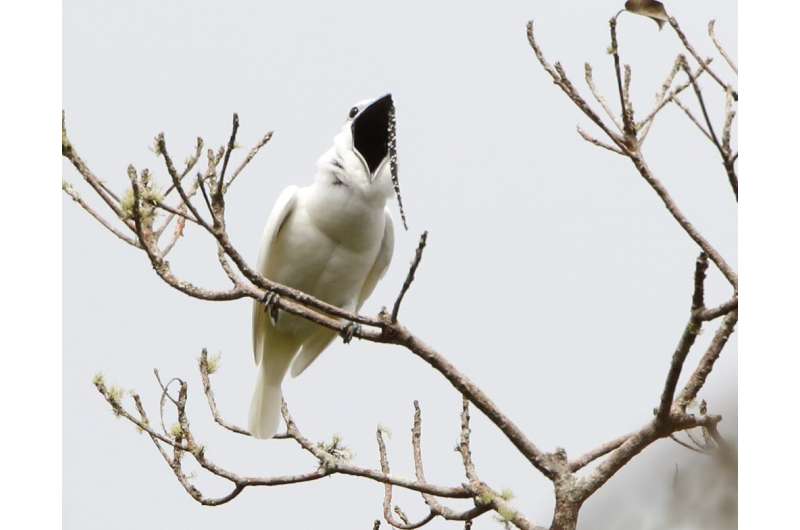Amazon's white bellbirds set new record for loudest bird call

Biologist Jeff Podos at the University of Massachusetts Amherst, with Mario Cohn-Haft at the Instituto Nacional de Pesquisas da Amazônia, Brazil, report that they have recorded the loudest bird calls ever documented, made by dove-sized male white bellbirds as part of their mating rituals in the mountains of the northern Amazon. Details are in the latest Current Biology.
Now recognized as the loudest in the world, bellbird calls have a sound pressure about three times that of screaming pihas, another Amazon species now demoted to the second loudest bird singer documented, the authors say. Podos says the songs are so deafening they reach decibel levels equal to the loudest human instruments. They measured pressure using a new generation sound level meter. These instruments allow one to take calibrated measures of amplitude with very high temporal precision, he adds. "This allows us to see how ampliutide changes and peaks within individual singing events."
The researchers note that it's actually hard to describe how loud the bellbird's call is, because it's difficult to compare sounds from different distances. But the calls are so loud, they wonder how white bellbird females listen at close range without damaging their hearing. Calls of howler monkeys and bison are well studied and quite loud, Podos, an expert in bioacoustics, points out, but not nearly as loud as the impressive bellbirds, who weigh about half a pound (1/4 kg) compared to the larger mammals.
Podos says, "We were lucky enough to see females join males on their display perches. In these cases, we saw that the males sing only their loudest songs. Not only that, they swivel dramatically during these songs, so as to blast the song's final note directly at the females. We would love to know why females willingly stay so close to males as they sing so loudly," he says. "Maybe they are trying to assess males up close, though at the risk of some damage to their hearing systems."
For this work supported by a Fulbright scholarship to Podos, he and Cohn-Haft used high-quality sound recorders plus special sound-level meters and high-speed video to slow the action enough for study.
Among other goals, they tried to identify adaptations such as breathing musculature, head and beak size, the shape of the throat and how these may influence the unusual aptitude the birds have for long-distance song transmission, a topic that has been very poorly studied, Podos says. "We don't know how small animals manage to get so loud. We are truly at the early stages of understanding this biodiversity."
One of the new things the researchers learned is that there seems to be a trade-off at work for this behavior—as bellbird and piha songs get louder, they get shorter, they report. This may be because the birds' respiratory systems have a finite ability to control airflow and generate sound.
Podos says the national institute in the Amazon's largest city Manaus, is a global hub for studying biodiversity. His co-author, Cohn-Haft, who grew up in Williamsburg, Mass., not far from the UMass Amherst campus, is curator of birds at the national institute and a world expert on Amazonian birds and their identification. Cohn-Haft has been leading expeditions for years into remote Amazon areas to find and characterize bird species, habitats, behavior and vocalizations, which still are little known.

In these earlier expeditions, Cohn-Haft noticed that the bellbirds had some interesting anatomical features, including unusually thick, well-developed abdominal muscles and ribs, but science knew almost nothing about this, which led to the expedition. Podos says their recent discoveries in bellbirds in this rarely studied area of body structures shaped by natural selection provides new information, and an example of the consequences of sexual selection, which drives the evolution of exaggerated traits such as loud singing.
Podos says their studies also contribute important new findings about bird communication and song, "the glue that holds bird societies together," and how they diverged morphologically by natural selection that changes the kind of songs they can sing and their social interactions. In future studies, Cohn-Haft says, he wants to further explore "the physical and anatomical structures and behaviors that allow bellbirds to produce such loud sounds and to endure them without hearing damage."
More information: Current Biology, Podos and Cohn-Haft: "Extremely loud mating songs at close range in white bellbirds" www.cell.com/current-biology/f … 0960-9822(19)31190-X , DOI: 10.1016/j.cub.2019.09.028
Journal information: Current Biology
Provided by University of Massachusetts Amherst
















